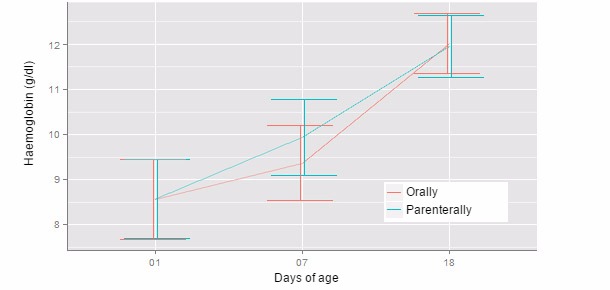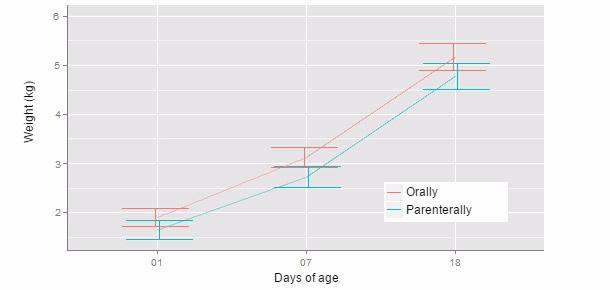Iron deficiency anaemia of piglets is an important pig production problem that causes stunted growth and increased mortality during lactation. Affected piglets exhibit dyspnea, fatigue, pale skin and mucous membranes and increased susceptibility to diseases.
Iron stores of piglets at birth are about 50 mg (Venn et al., 1947) and during the first weeks of life piglets double their weight while their plasma volume expands by 30% (Jain, 1986). Iron requirements for the synthesis of enough haemoglobin to prevent anaemia are high, at least 10 mg per day (Venn et al., 1947), but sow's milk contributes only 1 mg daily (Kleinbeck and McGlone, 1999) and, since piglets have no access to soil, they need an exogenous supplement.

Traditionally, the route used to deliver exogenous iron is parenteral, as iron dextran, iron dextrin or gleptoferron, at doses of 150-200 mg per piglet in a single application during the first four days of life (Egeli and Framstad, 1999). Sometimes this iron also fails to meet the piglet's needs because of its absorption kinetics, since between 10 and 50% can be retained in the inoculation site (Miller and Ullrey, 1999).
An alternative to meet their iron needs is to supplement organic iron orally, by a single administration as an oral paste or diluted in drinking water, avoiding iron contaminated inoculations —which are related to the onset of polyarthritis (Holmgren, 1996)— and facilitating the management of lactating animals.
A study was conducted on a commercial farm to test the effect of the administration of a treatment with organic iron in drinking water during lactation versus a traditional parenteral treatment with inorganic iron in the first days of the piglets' life.
Twenty-four (24) litters were divided into two groups: 128 piglets in 12 litters were offered a 3% glutamic acid solution with 24 g/L of chelated iron in the drinking water ad libitum from birth to 18 days; 133 piglets in another 12 litters received a dose of 150 mg dextran iron between 1 and 4 days of age. The groups were balanced by the sows' cycle number. To measure the concentration of haemoglobin a blood sample was extracted to 12 piglets per group (one per litter, selected randomly amongst the piglets weighing more than 1.4 kg), and all piglets were weighed individually at 1, 7 and 18 days of age.
Statistical analysis of data was performed using R (R Core Team, 2015) and each batch was considered an experimental unit. Haemoglobin concentration and weight were evaluated using a variance analysis with repeated measures and a mixed model that included, as fixed effects: treatment, sex, the sow's cycle (primiparous or multiparous), age and treatment-age interaction. Average daily gain was evaluated by a variance analysis, using a mixed model that included treatment, sex and cycle as fixed effects, and the initial weight as a covariate. The litter was included as a random effect on all models.
Haemoglobin concentration (Figure 1) was similar (p>0.05) in piglets treated orally and parenterally (p> 0.05). Without exogenous supplementation, haemoglobin concentration in the first days of life of piglets is low and its kinetic energy decreasing: 9.4 g / dL on farrowing day, 8.1 g / dL at 3 days of age and 7.8 g / dL at 4 days of age (Egeli and Framstad, 1999.) This study showed a progressive increase in haemoglobin concentration with both treatments. Haemoglobin concentration remained above 8 g / dL, beyond which level clinical signs of anaemia (Furugouri, 1975 and van Kempen, 1987) and production losses (Svoboda and Drábek, 2002) begin to appear, reaching 12 ± 0.3 g / dL at 18 days of age, which is considered within the normal range (Miller and Ullrey, 1999.)

Figure 1. Average concentration of haemoglobin (g / dL) on days 1, 7 and 18 after farrowing (mean least square ± standard error).
No differences in weight (Figure 2) or growth (Table 1) were observed between piglets treated orally and parenterally (p> 0.05). Jorgensen (2000) noted that when piglets have enough milk, they ingest little water and, consequently, little iron solution. The growth observed in this study indicates that milk production of sows was adequate, and the concentration of haemoglobin in blood suggests that the piglets received proper iron supplementation.

Figure 2. Average weight of piglets (kg) on days 1, 7 and 18 after farrowing (mean least square ± standard error.)
Table 1. Average daily gain (g / d) (mean least square ± standard error.)
| Average daily gain (g) | ORALLY | PARENTERALLY | P-value |
| First week of life | 182 ± 9.6 | 183 ± 9.8 | 0.937 |
| Between 7 and 18 days of age | 173 ± 14.0 | 175 ± 14.2 | 0.895 |
| Between 1 and 18 days of age | 180 ± 12.1 | 180 ± 12.3 | 0.972 |
The results observed in this study suggest that supplementation with organic iron in the drinking water of piglets during lactation may be an alternative to the administration of inorganic iron parenterally, supplying an appropriate level of iron to prevent iron-deficiency anaemia without affecting the growth and weight of piglets.



